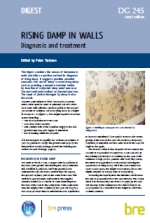Rising damp in walls - diagnosis and treatment (DG 245)
BRE (Building Research Establishment) is an independent, research-based consultancy, testing and training organisation, operating in the built environment and associated industries.
On 12 October 2007, BRE published Rising damp in walls - diagnosis and treatment (DG 245 revised edition), written by Peter Trotman.
Excess moisture is a common problem in buildings, and may be apparent from; damp patches, mould growth, mildew, salts, staining, ‘tide marks', blistering paint, bulging plaster and so on.
Rising damp is caused by capillary action drawing moisture up through porous elements of a building’s fabric. DG 245 considers the causes of rising damp in walls and how to remedy it if found.
Porous walls which stand in water or saturated soil without a damp proof course (dpc) can have rising damp to a height of more than 1m, with the height depending on:
- The rate of evaporation from the wall.
- The porosity of the wall.
- The salt content of the wall and soil.
- The groundwater height and saturation.
- Heating in the building.
Some accumulation of salts can occur in the walls of old buildings even when they do not have a damp problem, so high readings from a moisture meter alone are not conclusive. Appendix A of the 12-page digest describes how to drill samples from a wall in to test for moisture content and hygroscopicity, and the interpretation of moisture gradient profiles.
If a building has a physical damp-proof course (DPC), it is unlikely that it has failed, as most dpc materials have a long life, however, defects such as mortar droppings in a cavity wall, may make a dpc ineffective by bridging it and allowing moisture to pass up through the wall. This and other mechanisms by which an existing dpc might be bridged are discussed.
If it is necessary to provide a new moisture barrier, the digest explains methods such as; inserting a membrane or using chemical injection. The repair of plaster damaged by damp is also discussed.
The content of the digest includes:
- Mechanism of rising damp.
- Diagnosis.
- Determining the source of the dampness.
- Treatment.
- Replastering.
- Dry lining.
- Further reading.
- Appendix: The sampling method.
[edit] Related articles on Designing Buildings Wiki
- Assessing moisture in porous building materials.
- BRE articles on Designing Buildings Wiki.
- Building Research Establishment.
- Carbide meter.
- Condensation.
- Damp.
- Damp-proof course.
- Damp proof membrane.
- Defects in brickwork.
- Dew point.
- Diagnosing the causes of dampness (GR 5 revised).
- Does damp proofing work?
- Efflorescence.
- Electrical resistance meters.
- Interstitial condensation.
- Mould growth.
- Penetrating damp.
- Psychometric chart.
- Rising damp.
- Sling psychrometer.
- Spalling.
- Tanking.
- Treating brickwork with sealant or water repellent.
- Understanding dampness.
[edit] External references
Featured articles and news
One of the most impressive Victorian architects. Book review.
RTPI leader to become new CIOB Chief Executive Officer
Dr Victoria Hills MRTPI, FICE to take over after Caroline Gumble’s departure.
Social and affordable housing, a long term plan for delivery
The “Delivering a Decade of Renewal for Social and Affordable Housing” strategy sets out future path.
A change to adoptive architecture
Effects of global weather warming on architectural detailing, material choice and human interaction.
The proposed publicly owned and backed subsidiary of Homes England, to facilitate new homes.
How big is the problem and what can we do to mitigate the effects?
Overheating guidance and tools for building designers
A number of cool guides to help with the heat.
The UK's Modern Industrial Strategy: A 10 year plan
Previous consultation criticism, current key elements and general support with some persisting reservations.
Building Safety Regulator reforms
New roles, new staff and a new fast track service pave the way for a single construction regulator.
Architectural Technologist CPDs and Communications
CIAT CPD… and how you can do it!
Cooling centres and cool spaces
Managing extreme heat in cities by directing the public to places for heat stress relief and water sources.
Winter gardens: A brief history and warm variations
Extending the season with glass in different forms and terms.
Restoring Great Yarmouth's Winter Gardens
Transforming one of the least sustainable constructions imaginable.
Construction Skills Mission Board launch sector drive
Newly formed government and industry collaboration set strategy for recruiting an additional 100,000 construction workers a year.
New Architects Code comes into effect in September 2025
ARB Architects Code of Conduct and Practice available with ongoing consultation regarding guidance.
Welsh Skills Body (Medr) launches ambitious plan
The new skills body brings together funding and regulation of tertiary education and research for the devolved nation.
Paul Gandy FCIOB announced as next CIOB President
Former Tilbury Douglas CEO takes helm.

























Comments